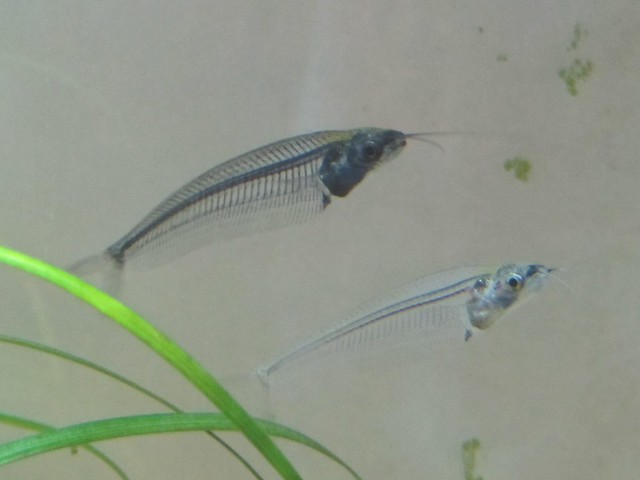 |
| Photo by JCVD100 (CC) |
The Phantom Glass Catfish is often identified as Kryptopterus bicirrhis, but the ones offered for sale are more likely to be Kryptopterus minor, a similar but rather smaller species. Kryptopterus bicirrhis will grow to about 10 inches (25cm) long while Kryptopterus minor only grows to about 3 inches (8cm).
The Phantom Glass Catfish is sometimes called the Glass Catfish, Ghost Catfish, or the Asian Catfish. There is a further possible confusion with the African Glass Catfish, Parailia pellucida, sometimes being sold as the Glass Catfish.
The Phantom Glass Catfish comes from South East Asia including Thailand, Malaysia and Indonesia. It comes from streams with sluggish currents, often with areas of still water.
Water Conditions
In the wild the water this fish often lives in is cloudy with suspended sediments. In these conditions this transparent fish is very difficult to see; fish's transparency acts as an excellent camouflage. This is not a condition normally aimed for in a home aquarium.
In an aquarium they will take neutral water (7). A temperature of 24 degrees C (75 degrees F) is suitable. We have no trouble with the moderate hardness of our Adelaide Hills water with this fish.
The tank should be heavily planted.
Food
This fish is a predator. It will eat other fish up to the size of a newly born Guppy. More normal foods for it include mosquito larvae and Daphnia. I find that they will eat a normal, good quality fish flake without any trouble but I have seen reports of them being difficult to feed.
Companions
The Phantom Glass Catfish is much more comfortable in a school of at least 5.
Although the Phantom Glass Catfish is a predator, it is peaceful to other fish as long as is cannot swallow them with its quite small mouth. They will certainly eat baby fish, but all reasonable sized adult fish, even small Neon Tetras, Cardinal Tetras and Green Neon Tetras are safe.
Other suitable companions include Diamond Tetras, Splashing Tetras, White Cloud Mountain Minnows, Cherry Barbs, Penguin Tetras, Pristella Tetras, Glowlight Tetras, Red EyeTetras, Silvertip Tetras, Gold Barbs, Rummy Nose Tetras, Scissortail Rasboras, Lemon Tetras, Emperor Tetras, Head and Tail Light Tetras, Glass Bloodfin Tetras, Swordtails, Platies, Mollies, Zebra Danios, Black Widow Tetras, Rosy Barbs, Tiger Barbs, Paraguay Tetras, Buenos Aires Tetras and Colombian Tetras. They are also OK with Siamese Fighting Fish, Guppies and Endlers Guppies.
Breeding
It is claimed that in Asia techniques have been worked out for breeding the Phantom Glass Catfish. If this is so, I have been unable to find out the method. Possibly the commercial people who do this prefer not to tell possible competitors about their methods.
There have been rare reports of the breeding of this fish and these suggestions are based on these reports.
Feed well before hand with live food such as mosquito larvae. Simulate the start of the rainy season by daily partial water changes using soft water. Lower the water level and lower the temperature by about 2 degrees C (3 degrees F).
The eggs, in the unlikely event that you succeed in getting any, are laid on plants, perhaps a couple of hundred from each female.
The parents should be removed and the fry fed on small live food.
Fish Sauce
The Phantom Glass Catfish is a major ingredient of some of the salty fish sauces used in Asian cooking.
Wild Caught
Unlike the great majority of the fish we sell, at least some of our Phantom Glass Catfish are caught in the wild. This fish is very common in some places and is not threatened.
Pest Fish
Do not release any pet fish into the wild, or keep them where they can escape.
Steve Challis has many other fish fact sheets and other articles on http://www.bettatrading.com.au
Article Source: EzineArticles
|


No comments:
Post a Comment